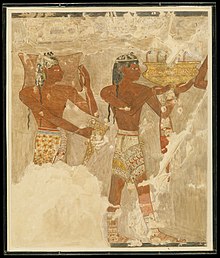
Rekhmire was an ancient Egyptian noble and official of the 18th Dynasty who served as "Governor of the Town" (Thebes) and Vizier during the reigns of Thutmosis III and Amenhotep II, circa 1400 BCE. He was the nephew of Vizier User, who took office at the time of the fifth year of Queen Hatshepsut’s reign. User's official titles included mayor of the city, vizier, and prince. Rekhmire is noted for constructing a lavishly decorated tomb for himself in Sheikh Abd el-Qurna, part of the Theban Necropolis, containing lively, well preserved scenes of daily life during the Egyptian New Kingdom. His tomb is also important as it contains a full copy of a text detailing the duties of the office of the vizier, known as the Installation of the Vizier.
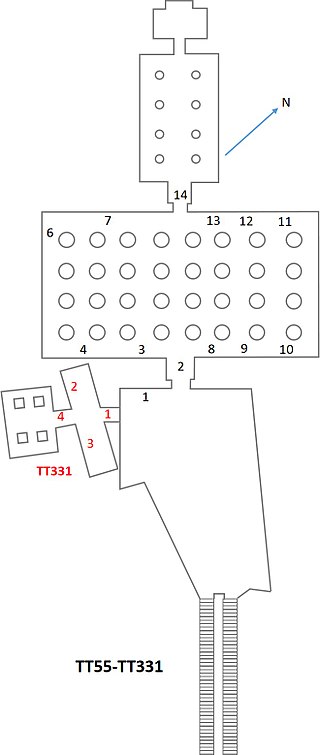
Tomb TT55 is located in Sheikh Abd el-Qurna, part of the Theban Necropolis, on the west bank of the Nile, opposite to Luxor. It is the burial place of the ancient Egyptian Vizier Ramose. It has a main room originally containing thirty-two columns and a corridor with eight columns. This tomb is notable for the high quality decorations in both the traditional and Amarna styles.

The Theban Tomb TT96 is located in Sheikh Abd el-Qurna. It forms part of the Theban Necropolis, situated on the west bank of the Nile opposite Luxor. The edifice is the burial place of the ancient Egyptian noble, Sennefer and wife Meryt.
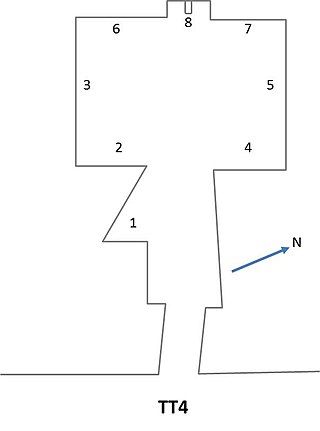
The Theban Tomb TT4 is located in Deir el-Medina, part of the Theban Necropolis, on the west bank of the Nile, opposite to Luxor. It is the burial place of the ancient Egyptian artisan named Qen.
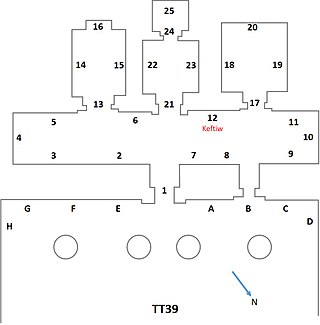
The Theban Tomb TT39 is located in El-Khokha, part of the Theban Necropolis, on the west bank of the Nile, opposite to Luxor. It is the burial place of the ancient Egyptian official, Puimre.
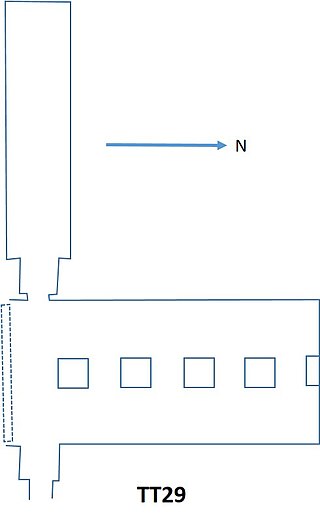
The Theban tomb TT29 is located in Sheikh Abd el-Qurna, part of the Theban Necropolis, on the west bank of the Nile, opposite to Luxor. It is the burial place of the ancient Egyptian noble Amenemopet called Pairy who was vizier and governor of Thebes.

The Theban Tomb TT359 is located in Deir el-Medina, part of the Theban Necropolis, on the west bank of the Nile, opposite to Luxor. It is the burial place of the ancient Egyptian workman Inherkhau, who was Foreman of the Lord of the Two Lands in the Place of Truth during the reigns of Ramesses III and Ramesses IV. He also owned Tomb TT299. Inherkau was the son of the similarly titled Foreman Huy. Inherkau's wife was named Wab.

The Theban Tomb TT31 is located in Sheikh Abd el-Qurna, part of the Theban Necropolis, on the west bank of the Nile, opposite to Luxor. It is the burial place of the ancient Egyptian official, Khonsu, who was First Prophet of Menkheperre, during the 19th Dynasty or 20th Dynasty.
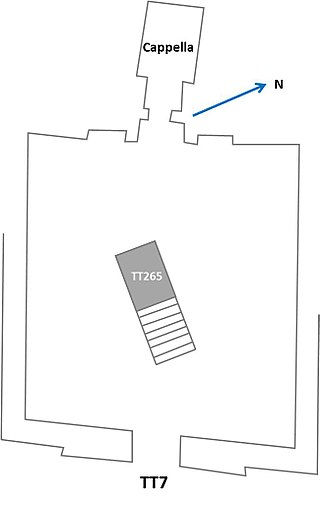
The Theban Tomb TT7 is located in Deir el-Medina, part of the Theban Necropolis, on the west bank of the Nile, opposite to Luxor. It is the burial place of the ancient Egyptian artisan named Ramose, who lived during the 19th Dynasty, during the reign of Ramesses II.
Amethu called Ahmose was a vizier of ancient Egypt. He served during the reign of Thutmose II and the early years of the reign of Hatshepsut and Thutmose III of the 18th Dynasty.
The Theban Tomb TT48 is located in El-Khokha, part of the Theban Necropolis, on the west bank of the Nile, opposite to Luxor. TT48 was the burial place of the ancient Egyptian named Amenemhat called Surer, who was a Chief Steward, At the head of the King, Overseer of the Cattle of Amun. Amenemhat called Surer dates to the time of Amenhotep III from the middle of the Eighteenth Dynasty of Egypt. He was a son of Ith-taui, who was an overseer of the cattle of Amun and the lady Mut-tuy.

The Theban Tomb TT58 is located in Sheikh Abd el-Qurna, part of the Theban Necropolis, on the west bank of the Nile, opposite to Luxor. The tomb was originally carved for a courtier dating to the time of Amenhotep III and later usurped during the Ramesside period.
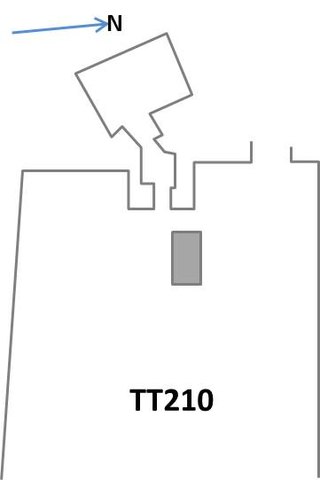
The Theban Tomb TT210, part of the Theban Necropolis, is located in Deir el-Medina, on the west bank of the Nile, opposite to Luxor. TT210 is the burial place of the ancient Egyptian artisan named Raweben, who lived during the 19th Dynasty. Raweben would have lived in Deir el-Medina during the reign of Ramesses II.

The Theban Tomb TT82 is located in Sheikh Abd el-Qurna, part of the Theban Necropolis, on the west bank of the Nile, opposite to Luxor. It is the burial place of the ancient Egyptian official Amenemhat, who was a counter of the grain of Amun and the steward of the vizier Useramen. Amenemhat dates to the Eighteenth Dynasty of Egypt, from the time of Tuthmosis III. As the scribe to the vizier Useramen Amenemhat documents the work in Thebes up to ca year 28. This includes the withdrawal of silver, precious stines and more form the treasury and the manufacture of a number of statues made from silver, bronze and ebony. He also mentions the creation of a large lake near Thebes surrounded by trees and work on the royal tomb.
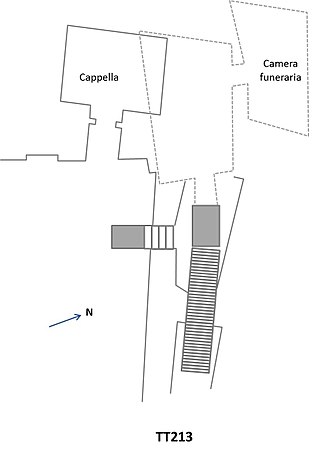
The Theban Tomb TT213 is located in Deir el-Medina, part of the Theban Necropolis, on the west bank of the Nile, opposite to Luxor.
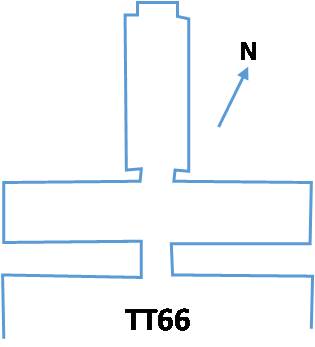
The Theban Tomb TT66 is located in Sheikh Abd el-Qurna. It forms part of the Theban Necropolis, situated on the west bank of the Nile opposite Luxor. The tomb is the burial place of the ancient Egyptian Vizier Hepu, who served during the reign of Tuthmosis IV.
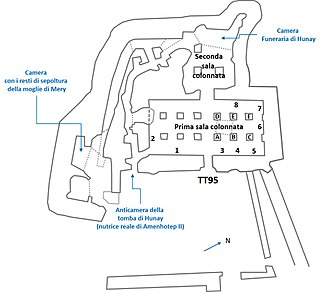
The Theban Tomb TT95 is located in Sheikh Abd el-Qurna, part of the Theban Necropolis, on the west bank of the Nile, opposite to Luxor. The tomb belongs to an ancient Egyptian named Mery, who was a High Priest of Amun at Karnak, during the reign of pharaoh Amenhotep II of the 18th Dynasty. Mery was the son of the First Prophet of Min of Koptos (Qift) named Nebpehtire and the Lady Hunayt. Mery's wife was named Dey.
Theban Tomb TT72 is located in the Theban Necropolis, on the west bank of the Nile, opposite to Luxor. It was the tomb of Re, who was the First Prophet of Amun in the Mortuary temple of Thutmosis III. The tomb is located in the necropolis area around Sheikh Abd el-Qurna and dates to the time of Amenhotep II.

The Theban Tomb TT83 is located in Sheikh Abd el-Qurna, part of the Theban Necropolis, on the west bank of the Nile, opposite to Luxor. It is the burial place of the ancient Egyptian official, Amethu called Ahmose, who was the Governor of the town and Vizier. Amethu called Ahmose dates to the Eighteenth Dynasty of Egypt, from the time of Tuthmosis III.

The Theban Tomb TT120 is located in Sheikh Abd el-Qurna. It forms part of the Theban Necropolis, situated on the west bank of the Nile opposite Luxor. The tomb is the burial place of the ancient Egyptian official Ahmose, who was the second prophet of Amun-Ra at Karnak and later the first prophet of Amun at Henqet-Ankh, the mortuary temple of Tuthmosis III at Qurnah during the reign of the Tuthmosis III.





